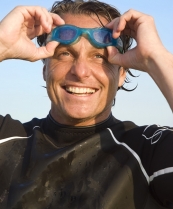3 Key Training Elements for Masters Athletes
Tuesday, February 10, 2015 - 09:00

Masters athletes is a term that encompasses a wide range of active men and women over 35 who compete in sports at a very high level; they can range from the weekend warrior to elite competitor. Baby boomers are a large part of the growing number of older adults who are either picking up a new sport or continuing to train and compete over the course of their life. Not surprising that these athletes are more fit than your average adult, with the majority of them being healthier and just as competitive as people half their age.
Since our bodies change as we get older, masters athletes, their coaches, and health practitioners should all be aware of any training requirements that may need to be adjusted for optimal performance.
Strength Training – We all lose muscle mass as we get older so keeping muscles strong becomes even more crucial for competitive masters athletes. Strength training for older adults should be the similar to anyone just starting out, by beginning slowly with an increase in intensity of no more than 10% per week. The American College of Sports Medicine (ACSM), recommends older adults perform two strength training sessions per week with each session including 8 to 10 different exercises for each of the major muscle groups. Proactively taking steps to increase muscle mass enables athletes to maintain proper technique and assists the body’s ability to absorb repetitive impacts, like running or jumping which ultimately leads to better performance.
Without active strength training, the average person between 25 and 50 years will experience a 5–10% decline in muscle size. Between 50 and 65 there is a 15% decline and over 65 is another 25% loss.
Recovery – Rest and recovery are important elements of every training program but are particularly essential for masters athletes. Exercise tolerance to a particular workout is an important consideration since people over 50 years of age commonly have joint and muscle discomfort. Periods of recovery should be longer and more pronounced than for younger athletes, particularly after a hard workout or competition. This may mean extra sleep or an extra day of recovery added into the training schedule. Allowing extra time for the body to recover means less injuries and will help motivate a person to push harder in the next workout.
Nutrition - Nutrition requirements for older athletes remains essentially the same until around 50 years old. After 50 recommendations for vitamin D, calcium, and vitamin B6 increase as well as folate and vitamin B12. While protein is essential for building muscle mass, specific protein recommendations are not currently available since experts tend to disagree on how much is necessary for the aging body.
As we age, declines in performance are to be expected but may not be as drastic as previously thought. By understanding and recognizing some of the changes listed above and adjusting training programs when necessary, masters athletes will continue to make gains and seek to attain even higher athletic goals.
References from the SIRC Collection:
1. Callahan S. STRENGTH TRAINING TIPS FOR MASTERS ATHLETES. Triathlon Life. Spring2009 2009;12(2):108.
2. MCCALL P. PERFORMANCE TRAINING FOR MASTERS ATHLETES. IDEA Fitness Journal. November 2013;10(10):34-43.
3. Reaburn P, Dascombe B. Endurance performance in masters athletes. European Reviews Of Aging & Physical Activity. April 2008;5(1):31-42.
4. Signorile J. Periodize training for the masters athlete. Functional U. September 2007;5(5):1-13.
5. Sipe C. Training Masters Athletes. IDEA Fitness Journal. September 2008;5(8):44-51.